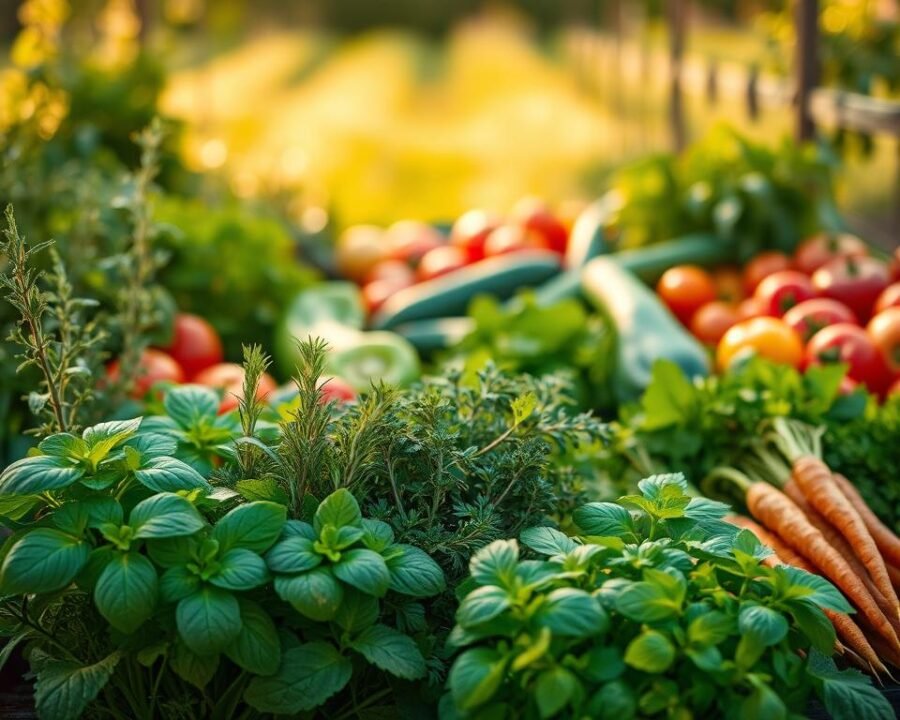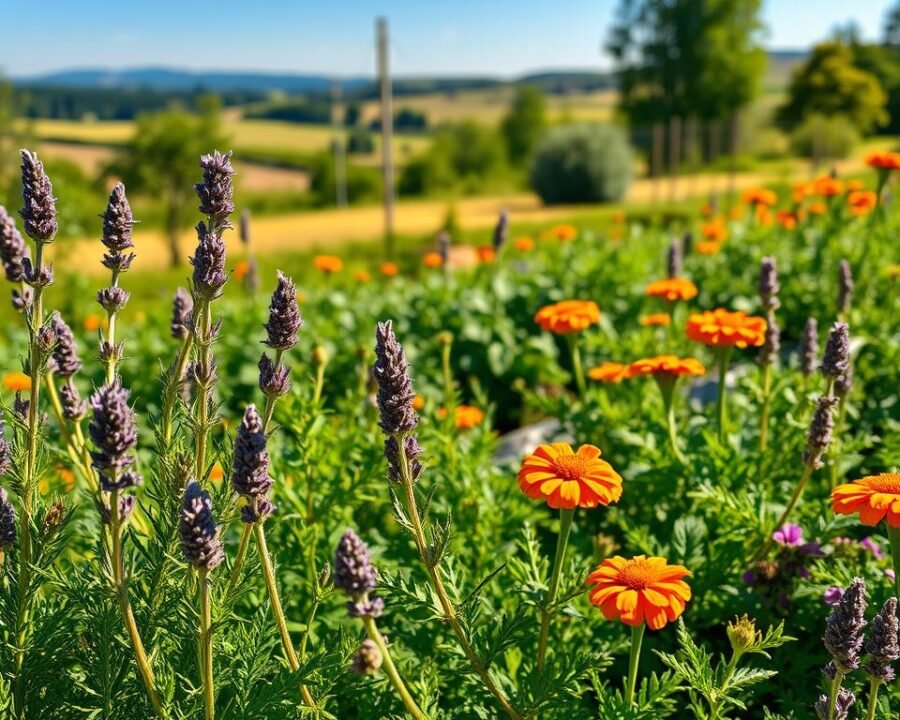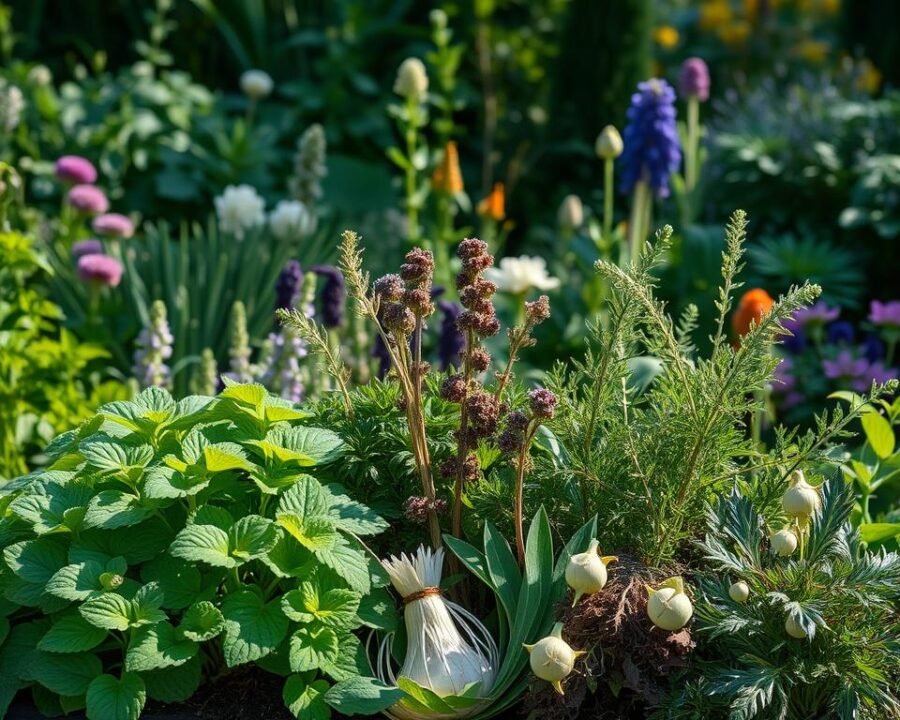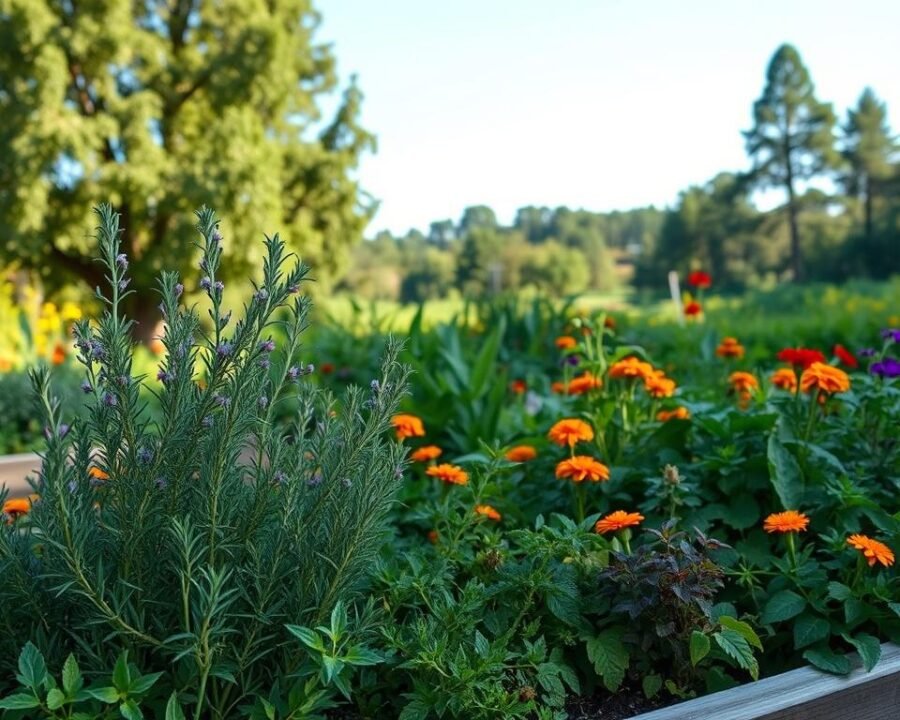Discover How to Grow Companion Planting Herbs Everyone Is Using
There’s something special about stepping into a thriving garden. The scent of fresh basil mingling with ripe tomatoes, or rosemary standing tall beside cabbage—nature has its own way of creating perfect harmony. These pairings aren’t just random; they’re time-tested strategies for healthier plants and richer flavors.
For centuries, gardeners have used companion planting to boost growth and deter pests naturally. Whether you’re a beginner or a seasoned green thumb, this method simplifies gardening while enhancing results. The right combinations can transform your space into a lush, fragrant paradise.
In this guide, we’ll explore the best herb partnerships, soil tips, and easy maintenance tricks. Let’s unlock the secrets of a flourishing garden—together.
Key Takeaways
- Pairing certain herbs improves growth and pest resistance naturally.
- Classic combos like basil and tomatoes enhance flavor and repel insects.
- Simple techniques make this method accessible for all skill levels.
- Healthy soil preparation is key to successful partnerships.
- Low-maintenance care keeps your garden thriving all season.
Why Companion Planting with Herbs Is a Game-Changer
Nature’s teamwork shines when herbs work together in harmony. These partnerships boost growth, deter pests, and even enhance flavors—all without chemicals. Let’s explore how strategic pairings revolutionize your green space.
Basil is a powerhouse. Its fragrant leaves repel whiteflies, mosquitoes, and aphids. Studies show tomatoes grown alongside basil yield 20–30% more fruit. The plant’s natural oils create a chemical barrier, shielding neighbors.
Dill plays a different role. Its umbrella-shaped flowers attract predatory wasps. These insects feast on cabbage worms, protecting brassicas like kale and broccoli. It’s a natural pest control system.
Don’t overlook marigolds. Their roots release a compound that kills root nematodes. Above ground, their bright blooms lure pollinators. One plant, two solutions.
| Herb | Benefit | Best Paired With |
|---|---|---|
| Basil | Repels 4+ pests; boosts tomato yields | Tomatoes, peppers |
| Dill | Attracts wasps to control cabbage worms | Cabbage, lettuce |
| Marigolds | Fights soil pests + supports bees | Tomatoes, squash |
Lavender adds another layer. Planted near apple trees, it confuses codling moths with its scent. This reduces fruit damage significantly. Every herb brings unique strengths to the garden.
These partnerships aren’t just effective—they’re easy. With the right combinations, your plants thrive with less effort. It’s gardening smarter, not harder.
How to Grow Companion Planting Herbs Everyone Is Using
Selecting herbs that complement each other unlocks nature’s full potential. The right pairings improve flavor, deter pests, and maximize space. Let’s explore how to match plants for success.
Matching Herbs to Your Garden’s Conditions
Basil loves moist soil and daily watering, while rosemary thrives in dry, sandy conditions. Mediterranean herbs like thyme need 6–8 hours of sun. Mints prefer partial shade (4–6 hours).
Test your soil’s pH—most planting herbs grow well near 6.5. Chives excel at 6.0–7.0. Kits like Luster Leaf or Sonkir provide quick readings.
Smart Companion Clusters
Group herbs with similar needs for easier care. Basil and oregano share moisture preferences. Rosemary and lavender both crave sunlight and well-drained soil.
Watch for invaders like mint. Plant it in containers to avoid overgrowth. For more companion planting herbs ideas, explore The Old Farmer’s Almanac.
- Basil + Oregano: Perfect for tomato beds.
- Rosemary + Lavender: Drought-tolerant duo.
- Parsley + Chives: Shade-friendly pair.
With these tips, your garden grows well with less effort. Pair wisely, and let nature do the rest.
Top Herb and Vegetable Pairings for a Thriving Garden
The right herb-vegetable pairings can transform your garden into a vibrant, pest-resistant oasis. These combinations leverage nature’s chemistry to enhance flavors, deter pests, and maximize space. Let’s explore three powerhouse teams.

Basil + Tomatoes: A Classic Duo
Basil does more than complement tomatoes in sauces—it boosts their growth. Research shows planting basil nearby increases tomato yields by 25%. Its terpene compounds enhance flavor while repelling whiteflies.
Try purple basil with heirloom tomatoes for a colorful, fragrant bed. Space plants 12 inches apart for optimal airflow.
Rosemary and Brassicas: Pest-Proof Partners
Rosemary’s strong scent confuses pests targeting brassicas like cabbage and kale. Its oils create a 3-foot protective barrier, reducing caterpillar damage by up to 60%.
Plant rosemary at the corners of brassica beds for full coverage. Drought-tolerant and low-maintenance, this duo thrives in sunny spots.
Chives with Carrots or Strawberries
Chives offer antifungal protection for strawberries and deter carrot flies. Their shallow roots interplant neatly with carrots, spaced 6 inches apart.
- Strawberry beds: Plant chives between rows to shield roots.
- Carrot rows: Alternate chives every 10 inches for pest control.
| Pairing | Key Benefit | Spacing |
|---|---|---|
| Basil + Tomatoes | 25% higher yields | 12 inches |
| Rosemary + Cabbage | 60% fewer pests | 3-foot radius |
| Chives + Carrots | Fly deterrence | 6 inches |
Herbs That Repel Common Garden Pests
Nature’s pest control squad lives right in your herb bed. Certain plants release scents and chemicals that bugs hate, creating a protective shield for nearby vegetables. We’ll explore two powerhouse defenders and smart strategies to maximize their effects.

Dill: The Cabbage Family’s Best Friend
Dill reduces cabbage worm damage by 60% when planted nearby. Its yellow flowers attract parasitic wasps that target these destructive larvae. Full protection kicks in within 4–6 weeks as the plant matures.
For best results:
- Plant 1 dill per 4 cabbage plants
- Position at bed edges for wasp access
- Allow some flowers to bloom for maximum attraction
Mint’s Multi-Pest Defense System
Mint repels over five beetle species plus aphids. Spearmint works best against spider mites, while peppermint deters flea beetles more effectively. Both varieties spread aggressively, so containment is key.
| Mint Type | Top Pest Targets | Planting Tip |
|---|---|---|
| Spearmint | Spider mites, ants | Use in hanging baskets |
| Peppermint | Flea beetles, aphids | Plant in buried pots |
Pro tip: Combine mint with nasturtiums near basil. These act as trap crops, luring aphids away from your main plants. The bright flowers also attract pollinators for a double benefit.
For invasive mints, install root barriers 12 inches deep. This lets you enjoy pest protection without garden takeover. With these warriors on duty, your plants thrive with fewer chemicals.
Herbs to Avoid Planting Together
Not all herbs play nicely together—some create toxic partnerships. While strategic pairings boost yields, others stunt growth or alter flavors. Knowing which plants clash saves time and ensures a thriving garden.

Basil and Rue: A Toxic Combo
Rue releases compounds that make nearby basil leaves bitter. Keep them at least 3 feet apart. This exclusion zone prevents chemical interference, preserving flavor and vitality.
Fennel’s Allelopathic Effects
Fennel is a garden bully. Its roots secrete substances that inhibit 80% of nearby plants. Tomatoes, beans, and peppers suffer most. Plant fennel in isolated beds or containers.
| Herb | Incompatible With | Alternative Placement |
|---|---|---|
| Basil | Rue, sage | Near tomatoes, peppers |
| Fennel | Most vegetables | Solo pots, herb spiral tops |
| Mint | Parsley, chamomile | Containers, shaded corners |
Recovery tip: If accidentally paired, relocate the aggressor herb promptly. Water affected plants with compost tea to stimulate recovery. Healthy soil buffers some allelopathic damage.
- Map exclusion zones: Rue’s 3-foot radius, fennel’s 4-foot root spread.
- Visual guides: Flag incompatible herbs with colored stakes.
- Test soil: Check pH after removing allelopathic plants.
Step-by-Step Guide to Planting Herbs with Companions
Strategic placement turns good gardens into great ones. Proper preparation ensures healthy soil and optimal growth conditions. Follow these steps to create harmonious plant partnerships.
Preparing Your Garden Bed
Start with the foundation. For raised beds, Organic Garden Co recommends 4’x8′ dimensions for easy access. Mix your soil with this recipe:
- 50% compost (nutrient-rich base)
- 30% coarse sand (drainage)
- 20% peat moss (moisture retention)
Test soil temperature before planting. Most herbs need consistent 60°F warmth. A basic soil thermometer ensures perfect timing.
“The right soil mix reduces watering needs by 40% while preventing root rot.”
Spacing and Layout Tips
Give plants room to thrive. Rosemary needs 18″ between plants, while creeping thyme spreads at 12″ intervals. Try these efficient patterns:
| Plant Type | Spacing | Layout Style |
|---|---|---|
| Tall herbs (rosemary, sage) | 18-24″ | North side of bed |
| Medium herbs (basil, oregano) | 12-15″ | Hexagonal clusters |
| Ground covers (thyme, mint) | 8-12″ | Border plantings |
Create a companion planting chart for reference. Layer plants vertically—tall specimens behind shorter ones. This maximizes sunlight exposure for all.
For continuous harvests, stagger planting dates every 2-3 weeks. Keep these tools handy:
- Dibbler for precise hole creation
- Measuring tape for accurate spacing
- Stakes for vine support
With these layout tips, your garden bed becomes a productive, beautiful space. Plants support each other naturally when given proper room and preparation.
Maintaining Your Companion Herb Garden
Proper maintenance ensures your companion herbs flourish together season after season. Each plant partnership has unique care requirements that, when met, maximize their mutual benefits. Let’s explore how to nurture these relationships through smart watering, feeding, and seasonal care.
Balancing Water and Nutrients
Herbs have different hydration needs. Basil thrives with consistent moisture, while lavender prefers dry spells between watering. The “taco test” helps gauge readiness—gently fold a leaf. If it cracks, water immediately; if flexible, wait.
Fertilizing requirements vary dramatically. Nitrogen-loving basil needs 5-1-1 NPK ratios, whereas rosemary flourishes with 2-1-1 mixes. Organic Garden Co recommends these blends:
| Herb Type | NPK Ratio | Frequency |
|---|---|---|
| Leafy (basil, mint) | 5-1-1 | Every 3 weeks |
| Woody (rosemary, thyme) | 2-1-1 | Spring/Fall |
| Flowering (lavender, chamomile) | 3-1-2 | Monthly |
Morning applications prevent leaf burn. Always water soil before fertilizing to protect roots.
Seasonal Pruning and Harvesting
Strategic pruning encourages bushier growth. For basil, pinch above leaf nodes every 3 weeks. Rosemary needs light shaping after flowering. Keep these calendars handy:
- Spring: Cut back winter damage
- Summer: Harvest before noon for peak oils
- Fall: Prepare plants for dormancy
Preserve your bounty with these methods:
- Air-dry thyme and oregano in bundles
- Freeze basil in olive oil cubes
- Infuse vinegars with rosemary sprigs
With these care techniques, your companion plants will support each other’s vitality year-round. Healthy maintenance leads to richer flavors and stronger pest resistance naturally.
Conclusion: Start Your Companion Planting Journey Today
Ready to transform your outdoor space with nature’s perfect pairings? Basil and tomatoes or rosemary with brassicas prove how simple combos yield big results. These teams boost flavors, deter pests, and save space effortlessly.
Start small—pick 2–3 proven duos. Organic Garden Co’s raised beds simplify setup for beginners. Their pre-mixed soil ensures healthy roots from day one.
Share your wins below! We’d love to hear which partnerships thrived in your garden. For quick reference, grab our free companion planting journey cheat sheet. It highlights top matches for every season.
With the right plants side by side, your harvests will flourish. Let’s grow smarter, together.







